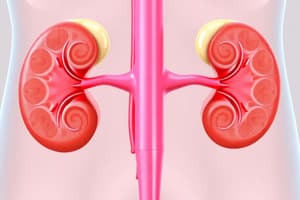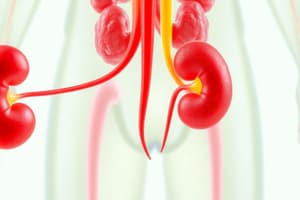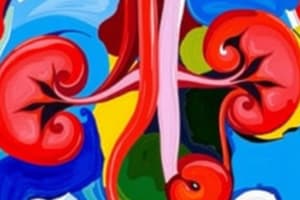Podcast
Questions and Answers
What is the most important route of waste removal
What is the most important route of waste removal
- Urination (correct)
- Defecation
- Digestion
- Perspiration
Produces urine
Produces urine
- Paired uterers
- Paired kidneys (correct)
- urinary bladder
- Urethra
Transports urine to urinary bladder
Transports urine to urinary bladder
- urethra
- loop of henle
- ureters (correct)
- proximal convoluted tubule
Collects and stores urine
Collects and stores urine
Transports urine out of the body
Transports urine out of the body
Why is erythropoietin important
Why is erythropoietin important
The kidneys produce some prostaglandins
The kidneys produce some prostaglandins
The kidneys help maintain homeostasis by manipulating _________________
The kidneys help maintain homeostasis by manipulating _________________
The kidneys ability to manipulate the composition of blood plasma helps to
The kidneys ability to manipulate the composition of blood plasma helps to
What are the substances kidneys help to get rid of that can become toxic if they build up
What are the substances kidneys help to get rid of that can become toxic if they build up
Which of the following is NOT a homeostatic function of the kidney
Which of the following is NOT a homeostatic function of the kidney
The amount of urine produced is controlled by _________
The amount of urine produced is controlled by _________
Maintains fluid balance regulation
Maintains fluid balance regulation
In order to maintain acid-base balance regulation what ions must be removed from blood and excreted in urine
In order to maintain acid-base balance regulation what ions must be removed from blood and excreted in urine
The kidneys have close association with the endocrine system, therefore they can influence the rate of release of some hormones, what are they
The kidneys have close association with the endocrine system, therefore they can influence the rate of release of some hormones, what are they
The kidney influences the release of ADH from the
The kidney influences the release of ADH from the
The mineralocorticoid secreted by the cortex of the adrenal gland is
The mineralocorticoid secreted by the cortex of the adrenal gland is
Specialized cells in the kidneys produce
Specialized cells in the kidneys produce
There are 3 MAIN mechanisms of renal waste elimination, what are they
There are 3 MAIN mechanisms of renal waste elimination, what are they
Filtration of blood occurs in the
Filtration of blood occurs in the
The fluid that is filtered out of blood is called
The fluid that is filtered out of blood is called
The glomerular capillaries have ____________ which forces plasma out of the capillaries into the ________________
The glomerular capillaries have ____________ which forces plasma out of the capillaries into the ________________
The transfer of plasma out of the glomerular capillaries is aided by _________
The transfer of plasma out of the glomerular capillaries is aided by _________
Both blood cells and plasma proteins are too ________ to __________
Both blood cells and plasma proteins are too ________ to __________
Too big to pass through the capillary endothelium
Too big to pass through the capillary endothelium
The presence of abnormal amounts of protein in the urine is used as
The presence of abnormal amounts of protein in the urine is used as
How fast blood plasma is filtered as it passes through the glumerolus is termed ___________--
How fast blood plasma is filtered as it passes through the glumerolus is termed ___________--
What is GFR dependent on
What is GFR dependent on
Approximately ______ of the plasma is removed from the blood circulation every minute
Approximately ______ of the plasma is removed from the blood circulation every minute
_______ reduces the volume of glomerular filtrate (urine) produced
_______ reduces the volume of glomerular filtrate (urine) produced
Glomerular filtrate contains waste products BUT __________
Glomerular filtrate contains waste products BUT __________
Reabsorption occurs from the ____ into the ______
Reabsorption occurs from the ____ into the ______
Glomerular filtrate leaves bowmans capsule and enters the ________, now the filtrate is called _________
Glomerular filtrate leaves bowmans capsule and enters the ________, now the filtrate is called _________
Approximately ____ of reabsorption occurs in the PCT
Approximately ____ of reabsorption occurs in the PCT
80% of _________ is reabsorbed
80% of _________ is reabsorbed
100% of _____ are reabsorbed
100% of _____ are reabsorbed
Reabsorption occurs via
Reabsorption occurs via
____________ "hitch a ride" on the same carrier protein and are ________ transported into PCT epithelial cells. This is called _____________
____________ "hitch a ride" on the same carrier protein and are ________ transported into PCT epithelial cells. This is called _____________
Reabsorption of _________ takes place in the ___________- via simple diffusion
Reabsorption of _________ takes place in the ___________- via simple diffusion
_________ reabsorption takes place in ___________ via unknown mechanisms that involve _____
_________ reabsorption takes place in ___________ via unknown mechanisms that involve _____
____________- is reabsorbed from _____ and the collecting duct and is increased by ______
____________- is reabsorbed from _____ and the collecting duct and is increased by ______
Most secretion takes place in
Most secretion takes place in
_________________ are eliminated by secretion in the DCT
_________________ are eliminated by secretion in the DCT
Urine volume is determine by _____________________ when it reaches the renal pelvis
Urine volume is determine by _____________________ when it reaches the renal pelvis
ADH acts on the _____________ to promote water reabsorption
ADH acts on the _____________ to promote water reabsorption
Without ADH water will not be reabsorbed which will cause increased urine volume, termed _________
Without ADH water will not be reabsorbed which will cause increased urine volume, termed _________
What causes an osmotic imbalance that results in water flowing back into the bloodstream along with sodium
What causes an osmotic imbalance that results in water flowing back into the bloodstream along with sodium
Aldosterone increases reabsorption of ____ in the ____ and ____ back into the blood
Aldosterone increases reabsorption of ____ in the ____ and ____ back into the blood
Expulsion of urine from urinary bladder into urethra for elimination from the body is termed =
Expulsion of urine from urinary bladder into urethra for elimination from the body is termed =
Reabsorption of sodium requires
Reabsorption of sodium requires
For any substance to be reabsorbed it must
For any substance to be reabsorbed it must
As glomerular filtrate enters the PCT ______ attaches to a carrier molecule in the tubular filtrate (___) and is transported passively into the _____ of the PCT epithelial cells
As glomerular filtrate enters the PCT ______ attaches to a carrier molecule in the tubular filtrate (___) and is transported passively into the _____ of the PCT epithelial cells
Sodium reabsorption occurs in the PCT, but additional reabsorption also occurs in the
Sodium reabsorption occurs in the PCT, but additional reabsorption also occurs in the
___________ passively follows sodium to balance out the ________ in the interstitium caused by the ______ sodium ions being pumped into the interstitial fluid
___________ passively follows sodium to balance out the ________ in the interstitium caused by the ______ sodium ions being pumped into the interstitial fluid
After sodium cotransport, sodium is actively ___________ and it enters the peritubular capillaries
After sodium cotransport, sodium is actively ___________ and it enters the peritubular capillaries
Sodium ions are usually exchanged for _____ that are then secreted into the tubular filtrate. This occurs under the influence of ?
Sodium ions are usually exchanged for _____ that are then secreted into the tubular filtrate. This occurs under the influence of ?
Increases reabsorption of sodium in the DCT and collecting ducts back into the blood
Increases reabsorption of sodium in the DCT and collecting ducts back into the blood
If the ___________ of glomerular capillaries is damaged _____________ can leak into the glomerular filtrate
If the ___________ of glomerular capillaries is damaged _____________ can leak into the glomerular filtrate
If the endothelium of glomerular capillaries is damaged proteins and blood cells can leak into the glomerular filtrate. __________ they will show up and they will show up as abnormal constituents of the urine
If the endothelium of glomerular capillaries is damaged proteins and blood cells can leak into the glomerular filtrate. __________ they will show up and they will show up as abnormal constituents of the urine
Ureters exit the kidney at the hilus and enter the bladder _____ at an oblique angle
Ureters exit the kidney at the hilus and enter the bladder _____ at an oblique angle
Urinary bladder
Urinary bladder
Fullness of urinary bladder is detected by _________
Fullness of urinary bladder is detected by _________
When the trigger point is reached, ______ is activated and returns a motor impulse and the smooth muscle of the wall ______. This is responsible for the sensation of having to urinate
When the trigger point is reached, ______ is activated and returns a motor impulse and the smooth muscle of the wall ______. This is responsible for the sensation of having to urinate
__________ control of the muscular sphincter around the _________ leads to temporary control of urination
__________ control of the muscular sphincter around the _________ leads to temporary control of urination
Continuation of the neck of bladder runs through the pelvic canal to the outside of the body through the __________ in males and the _________ in females
Continuation of the neck of bladder runs through the pelvic canal to the outside of the body through the __________ in males and the _________ in females
Transports spermatozoa and accessory reproductive gland secretions in male
Transports spermatozoa and accessory reproductive gland secretions in male
Cell division
Cell division
Animals may look alike but unless they are _______- they are not the same
Animals may look alike but unless they are _______- they are not the same
Contain the genetic material (blue print) for all the structures and functions in the body
Contain the genetic material (blue print) for all the structures and functions in the body
Where are chromosomes located
Where are chromosomes located
For the body to function correctly
For the body to function correctly
Fertilization
Fertilization
Diploid chromosome number
Diploid chromosome number
The diploid chromosome number is
The diploid chromosome number is
Sex chromosomes
Sex chromosomes
XX
XX
XY
XY
As a cell divides by ________ the total number of chromosomes in each daughter cell is ______ by half of the numbers that the parent had
As a cell divides by ________ the total number of chromosomes in each daughter cell is ______ by half of the numbers that the parent had
Most of the cells divide by a process called
Most of the cells divide by a process called
_______ results in each daughter cell having an identical, full diploid set of chromosomes
_______ results in each daughter cell having an identical, full diploid set of chromosomes
When the reproductive cells divide by _________ the chromosomes do not produce duplicate copies of themselves before the cells pull apart
When the reproductive cells divide by _________ the chromosomes do not produce duplicate copies of themselves before the cells pull apart
___________ of the total chromosomes, including _____ sex chromosome/s randomly goes to each daughter cell before the cell divides
___________ of the total chromosomes, including _____ sex chromosome/s randomly goes to each daughter cell before the cell divides
Half of the sperm cells produced have an X chromosome and a Y chromosome
Half of the sperm cells produced have an X chromosome and a Y chromosome
Ova are produced in
Ova are produced in
Production of ova involves a _______________ events under the influence of two hormones
Production of ova involves a _______________ events under the influence of two hormones
Production of ova involves a complex sequence of cyclical events under the influence of which hormones
Production of ova involves a complex sequence of cyclical events under the influence of which hormones
Rupture of the mature follicle with release of the oocyte (ova)
Rupture of the mature follicle with release of the oocyte (ova)
The oocyte is called a _________ after release into the uterine tube
The oocyte is called a _________ after release into the uterine tube
Ovulation occurs spontaneously due to rising ____ levels
Ovulation occurs spontaneously due to rising ____ levels
Example of induced ovulator/s
Example of induced ovulator/s
In induced ovulators, breeding must take place _______ to stimulate ovulation
In induced ovulators, breeding must take place _______ to stimulate ovulation
Endocrine signal must be sent from _______ to maintain the ___
Endocrine signal must be sent from _______ to maintain the ___
Designed to get the ovum and spermatozoa together in the right place at the right time
Designed to get the ovum and spermatozoa together in the right place at the right time
Estrous cycle is controlled by the hormone/s
Estrous cycle is controlled by the hormone/s
Breeding takes place during a ___________ within the reproductive cycle when the chance of a successful pregnancy is the highest
Breeding takes place during a ___________ within the reproductive cycle when the chance of a successful pregnancy is the highest
Detaches easily
Detaches easily
Loosely attached and detaches easily
Loosely attached and detaches easily
Life support system for the developing embryo/fetus
Life support system for the developing embryo/fetus
Placenta
Placenta
Contains blood vessels and the urachus
Contains blood vessels and the urachus
In some places the placenta actually attaches to the uterus (_____)
In some places the placenta actually attaches to the uterus (_____)
Consists of layers of soft membranes that form two fluid filled sacs
Consists of layers of soft membranes that form two fluid filled sacs
Match
Match
Match
Match
Trimesters
Trimesters
Gestation is divided into
Gestation is divided into
Stages of labor
Stages of labor
In multiparous species the second and third stages of parturition intermix with one another
In multiparous species the second and third stages of parturition intermix with one another
When it is time for parturition a series of events lead to the ovary to stop producing ________
When it is time for parturition a series of events lead to the ovary to stop producing ________
When it is time for parturition a series of events lead to the ovary to stop producing progesterone, leading to a massive decline in the damn
When it is time for parturition a series of events lead to the ovary to stop producing progesterone, leading to a massive decline in the damn
When it is time for parturition a series of events lead to the ovary to stop producing progesterone, leading to a massive increase in the damn
When it is time for parturition a series of events lead to the ovary to stop producing progesterone, leading to a massive increase in the damn
When it is time for parturition adrenal glucorticoids ______ in fetus and __________ in dams estrogen level and release of ______ from uterine wall
When it is time for parturition adrenal glucorticoids ______ in fetus and __________ in dams estrogen level and release of ______ from uterine wall
Estrogen and prostaglandins _____ the sensitivity of the myometrium to the ________ released from the dams posterior pituitary gland which causes _____ and ultimately, labor
Estrogen and prostaglandins _____ the sensitivity of the myometrium to the ________ released from the dams posterior pituitary gland which causes _____ and ultimately, labor
Produces colostrum
Produces colostrum
Only females produce milk due to hormones secreted
Only females produce milk due to hormones secreted
When nursing or milking begins, sensory nerve impulses are sent to the brain specifically the _________ and stimulates the _________
When nursing or milking begins, sensory nerve impulses are sent to the brain specifically the _________ and stimulates the _________
Hormones involved in lactation
Hormones involved in lactation
The _____________ and ___________ of mammary glands are the first step in making them able to produce milk
The _____________ and ___________ of mammary glands are the first step in making them able to produce milk
Number of mammary glands in the horse
Number of mammary glands in the horse
Mammary glands of the sheep and goat
Mammary glands of the sheep and goat
Mammary glands of the swine
Mammary glands of the swine
Mammary glands of the cow
Mammary glands of the cow
There is a variety in the number of openings from which milk flows from the nipples or teats
There is a variety in the number of openings from which milk flows from the nipples or teats
There is no variety in the number of openings from which milk flows from the nipples or teats, they are all uniform
There is no variety in the number of openings from which milk flows from the nipples or teats, they are all uniform
______ stimulates ______ cells around the alveoli and small ducts of mammary glands to ______, which is what squeezes the milk down in the ducts
______ stimulates ______ cells around the alveoli and small ducts of mammary glands to ______, which is what squeezes the milk down in the ducts
Flashcards are hidden until you start studying




